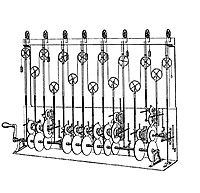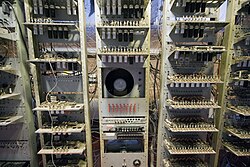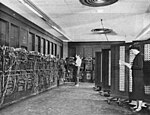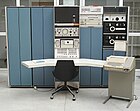កុំព្យូទ័រ
អត្ថបទនេះត្រូវបានសរសេរជាភាសាផ្សេង ដែលមិនមែនជាភាសាខ្មែរ។ បើសិនជាអត្ថបទទុកសម្រាប់អ្នកអានមកពី សហគមន៍នៃភាសាមួយនេះ វាគួរតែចែកចាយទៅវិគីភីឌាជាភាសានោះ។ សូមមើល បញ្ជីនៃគម្រោងវិគីភីឌាទាំងអស់។
| អត្ថបទនេះត្រូវការបកប្រែទៅជាភាសាខ្មែរ។ សូមមើល ច្រកចូលអត្ថបទនេះ លើក្រុមទំព័រដែលត្រូវការបំណកប្រែទៅជាភាសាខ្មែរ ដើម្បីពិភាក្សា ។ ប្រសិនបើ អត្ថបទមិនត្រូវបានសរសេរជាភាសាខ្មែរឡើងវិញទេ ក្នុងរយៈពេលពីរសប្ដាហ៍ទៀត អត្ថបទនឹងត្រូវចុះបញ្ជីដើម្បីលុបចោល និង/ឬ ប្ដូរវាទៅកាន់វិគីភីឌាជាភាសាដើមរបស់វាវិញ ។ បើសិនជាលោកអ្នក គ្រាន់តែចង់បិទស្លាកទំព័រនេះត្រូវការបំណកប្រែ សូមបញ្ចូល {{អាទេស.:ត្រូវការបកប្រែ | ទំ. = កុំព្យូទ័រ | ភាសា = មិនស្គាល់ | ផ្ដល់យោបល់ = }} ~~~~ទៅខាងក្រោម នៃផ្នែក នៃក្រុមទំព័រនេះត្រូវការបំណកប្រែទៅជាភាសាខ្មែរ ។ |
គណនូបករណ៍ (អសអ: ['keək-neək-nuː-pak'kɑ]) ឬ កុំព្យូទ័រ (អសអ: ['kom-pjuː-təːɨ]) គឺជាឧបករណ៍ ដែលអាចបំពេញតាមតម្រូវការប្រើប្រាស់គ្រប់យ៉ាងមួយប្រភេទ ដែលអាចសរសេរកម្មវិធីដើម្បីដឹកនាំនូវសំណុំប្រតិបត្តិកម្មខាងនព្វន្ត ឬ តក្កៈដោយស្វ័យប្រវត្តិ។ គណនូបករណ៍អាចដោះស្រាយបញ្ហាជាច្រើន ដោយហេតុថា លំដាប់លំដោយនៃប្រត្តិបត្ដិការ អាចត្រូវបានគេកែប្រែដោយងាយស្រួល។ វាជាម៉ាស៊ីនម៉្យាងដែលអាចផ្លាស់ប្ដូរព័ត៌មានយ៉ាងល្អ និងជាក់លាក់ជាទីបំផុតដោយយោងទៅតាមរូបមន្ដ និងច្បាប់ត្រឹមត្រូវ។ កុំព្យូទ័របាន ស្ថិតនៅជាមួយមនុស្សតាំងពីយូរយារណាស់មកហើយ។ កុំព្យូទ័រកាលពីមុនមានទំហំធំ និងមានការប្រើប្រាស់បានតិចតួច ក៏ប៉ុន្ដែកុំព្យូទ័រនាពេលបច្ចុប្បន្ន នេះវិញ មានការកែប្រែជាច្រើនយ៉ាង និងកាន់តែមានភាពងាយស្រួលជាងមុន។ គេបានកែប្រែទំហំ រូបរាង និងគុណប្រយោជន៏ ដែលធ្វើឱ្យការប្រើប្រាស់ កាន់តែមានភាពងាយស្រួលជាងមុន ព្រមទាំងចូលរួមបម្រើពិភពលោកកាន់តែបានច្រើន។ រហូតមកដល់ពេលបច្ចុប្បន្ននេះ កុំព្យូទ័របានក្លាយទៅជាឧបករណ៌ដ៏អស្ចារ្យ និងមានតម្លៃសម្រាប់មនុស្សទូទៅ។ កុំព្យូទ័រអាចធ្វើអ្វីៗគ្រប់យ៉ាង ដែលនរណាម្នាក់ចង់ អោយវាធ្វើ កុំព្យូទ័រអាចដោះស្រាយគណិតវិទ្យា ពីព្រោះអ្នកសរសេរកម្មវិធី បានប្រាប់កុំព្យូទ័រពីរបៀបដោះស្រាយ គណិតវិទ្យា ដោយហេតុនេះហើយ កុំព្យូទ័រមានភាពរហ័ស លឿន ទំនើប អាចដោះស្រាយបញ្ហាគណិតរាប់លានក្នុងមួយវិនាទីបាន។ កុំព្យូទ័រអាចគ្រប់គ្រងរោងចក្រជាច្រើន ដែលពី មុនមកធ្លាប់តែប្រើមនុស្សដើម្បីគ្រប់គ្រង តែពេលនេះគេបានប្រើកុំព្យូទ័រដើម្បីគ្រប់គ្រង វាមានភាពងាយស្រូល និងប្រសើរជាងមុនឆ្ងាយណាស់។
ជាធម្មតា គណនូបករណ៍មួយ យ៉ាងហោចណាស់ក៏មានវត្ថុធាតុដំណើរការមួយដែរ ជាពិសេស Central Processing Unit (CPU) និងទម្រង់ខ្លះទៀតនៃអង្គចងចាំ(Memory)។ វត្ថុធាតុដំណើរការនេះធ្វើប្រតិបត្តិកម្មនព្វន្តនិងតក្កៈ ហើយការដាក់តម្រៀបជាបន្តបន្ទាប់គ្នា និង អង្គត្រួតពិនិត្យអាចកែប្រែលំដាប់នៃប្រតិបត្តិកម្មអាស្រ័យលើព័ត៌មានដែលបានផ្ទុក។ គ្រឿងឧបករណ៍បរិមណ្ឌល អនុញ្ញាតឱ្យព័ត៌មានទាញយកបានពីប្រភពខាងក្រៅ និងជាលទ្ធផលនៃប្រតិបត្តិកម្មថតទុកព័ត៌មាន និង ទាញយកមកប្រើវិញ។
ក្នុងសង្គ្រាមលោកលើកទី២ គណនូបករណ៍អនុរូបដែលជាគ្រឿងយន្តត្រូវប្រើដើម្បកិច្ចអនុវត្តខាងយោធាឯកទេសកម្ម។ កំឡុងពេលនោះ គណនូបករណ៍ខ្ទង់លេខបែបអស្យាណូលើកដំបូងត្រូវបានអភិវឌ្ឍឡើង។ ដើមឡើយគណនូបករណ៍ទាំងនោះមានទំហំធំប៉ុនបន្ទប់ធំមួយ ប្រើអស់ថាមពលច្រើនស្មើនឹងគណនូបករណ៍ផ្ទាល់ខ្លួន (គ.ផ.) ទំនើបច្រើនរាប់រយដង។
គណនូបករណ៍ទំនើបពឹងផ្អែកទៅលើបរិថបសមាហរ័ណរាប់លានដល់រាប់រយកោដដង ដែលមានសមត្ថភាពច្រើនជាងគ្រឿងយន្តកាលពីមុនៗ ហើយនិងបំពេញមុខងារនៅត្រង់កន្លែងទំនេរជាផ្នែកតូចៗ។ គណនូបករណ៍ធម្មតាតូចល្មមត្រូវទៅនឹងគ្រឿងឧបករណ៍ចល័ត និងគណនូបករណ៍ចល័តអាចបញ្ចូលថាមពលបានដោយថ្មតូចៗ។ គណនូបករណ៍ផ្ទាល់ខ្លួនក្នុងទម្រង់ផ្សេងៗគឺជានិមិត្តសញ្ញានៃយុគព័ត៌មាន ហើយក៏ជាអ្វីដែលធ្វើឱ្យមនុស្សភាគច្រើនគិតដល់ “គណនូបករណ៍។” យ៉ាងណាក៏ដោយ គណនូបករណ៍បានបង្កប់ខ្លួនដែលគេឃើញមាននៅក្នុងគ្រឿងឧបករណ៍ជាច្រើនចាប់ពីម៉ាញ៉េ MP3រហូតដល់យន្តហោះប្រឆាំងយន្តហោះ និងចាប់ពី ប្រដាប់ក្មេងលេងរហូតដល់រូបយន្តឧស្សាហកម្មដែលឃើញមានភាគច្រើនបំផុត។

និរុត្តិសាស្ត្រ
ការប្រើប្រាស់ពាក្យនេះដំបូង “computer” ឬ កុំព្យូទ័រ ត្រូវបានគេកត់ត្រាទុកនៅឆ្នាំ ១៦១៣ ក្នុងសៀវភៅ “The yong mans gleanings” ដោយអ្នកនិពន្ធជាតិអង់គ្លេស រីឆាដ-ប្រេថវ៉េត I haue read the truest computer of Times, and the best Arithmetician that euer breathed, and he reduceth thy dayes into a short number។ វាសំដៅទៅលើបុគ្គលម្នាក់ធ្វើការគិតលេខ ឬ គណនា និង ពាក្យនេះបានបន្តមកជាមួយអត្ថន័យដដែលរហូតដល់ពាក់កណ្ដាលនៃសតវត្សទី២០។ ចាប់ពីចុងសតវត្សទី១៩មក ពាក្យនេះបានចាប់ផ្ដើមទទួលបានអត្ថន័យដែលគេដឹងលឺបន្ថែមទៀត នោះគឺគ្រឿងយន្តដែលធ្វើការគណនាបានច្រើន។
កុំព្យូទ័រ ដំនើរការវិញតាមរយៈគណៈកម្មការជាតិភាសាខ្មែរ សំដៅលើ ម៉ាស៊ីនអេឡិចត្រូនិកមួយបែបដែលអាចបញ្ចូល រក្សាទុក គណនា វិភាគ ធ្វើសេចក្ដីសម្រេច និង ទាញយកទិន្នន័យ។
ពាក្យខ្មែរបកប្រែ ត្រូវនឹងពាក្យ គណនូបករណ៍ មកពីពាក្យ គណនា+ឧបករណ៍>គណនូបករណ៍។ មានន័យថា ឧបករណ៍ ឬ គ្រឿងយន្ត ដែលអាចគណនាបាន។ ពាក្យមួយទៀត អង្គុលីទស្សន៍ មិនដឹងមានប្រវត្តិមកពីណាទេ?? កាលពីមុនមានសៀវភៅ "ទុក្ខខ្មែរក្រោម" ដោយលោក ថាច់-សិរៈ បានប្រើការបកប្រែពាក្យ កុំព្យូទ័រ មកខ្មែរ ថា គណិតូបករណ៍ បើវិភាគលើពាក្យនេះ គណិត+ឧបករណ៍ មានន័យថាជាឧបករណ៍ទាក់ទងនឹងគណិត ខាងលេខ តែពាក្យនេះវាសាកសមត្រូវនឹងដែលវាវិវត្តពីក្បាចដែលភាសាអង់គ្លេសថា calculator។
ប្រវត្តិ
ហ៊ុត ផាន់ណា
ដំនើរការវិញ
ឧបករណ៍គិតលេខជាបឋមវិធានលើកដំបូងបានបង្ហាញខ្លួនក្នុងបុរាណកាលនិងគ្រឿងជំនួយគិតលេខជាលក្ខណៈគ្រឿងយន្តត្រូវបានបង្កើតឡើងនៅសតវត្សទី១៧។ ជាលើកទីមួយហើយដែលគេបានកត់ត្រាការប្រើប្រាស់ពាក្យ "computer ឬ គណនាករ" មានចាប់ពីសតវត្សទី១៧មកម៉្លេះ ដែលដាក់ឱ្យប្រើសម្រាប់សំដៅលើអ្នកធ្វើការគណនា ជារឿយៗសំដៅលើការងារ។ គ្រឿងគណនូបករណ៍លើកដំបូងត្រូវបានច្នៃប្រឌិតឡើងនៅសតវត្សទី១៩ ហើយមិនតែប៉ុណ្ណោះទេវាក៏បានលេចឡើងនូវរូបរាងសណ្ឋានបែបទំនើបរបស់ខ្លួនក្នុងទសវត្សឆ្នាំ១៩៤០មកម៉្លេះ។ បើយោងតាមពាក្យអង់គ្លេស computer ឬ កុំព្យូទ័រ វាមានន័យថា គណនាករ អត្ថន័យទីមួយប្រើនៅសតវត្សទី១៧ គឺអ្នកដែលធ្វើការគណនា ចំណែកអត្ថន័យទីពីរវាមានន័យថា ឧបករណ៍គណនា ដែលត្រូវនឹងពាក្យខ្មែរបង្កើតថ្មីថា គណនូបករណ៍។
ឧបករណ៍គណនាសម្រេចបំណងទូទៅលើកដំបូង

លោកឆាលស៍-ប៊ែប៊ិច ជាវិស្វករគ្រឿងយន្ត និង ពហុវិញ្ញូជាតិអង់គ្លេសម្នាក់ បានបង្កើតទស្សនៈទាននៃគណនូបករណ៍អាចសរសេរកម្មវិធីបាន។ ត្រូវបានគេចាត់ទុកថាជា"បិតានៃគណនូបករណ៍ លោកបានធ្វើសមានញាណូបនីយកម្មនិងបានបង្កើតគណនូបករណ៍យន្តក្នុងដើមសតវត្សទី១៩។ បន្ទាប់ពីការធ្វើបន្តលើវិស្វៈសទិសភាពបដិវត្តន៍របស់លោក ដែលបានរចនាឡើងដើម្បីជួយក្នុងការគណនានាវាចរណ៍ ក្នុងឆ្នាំ១៨៣៣ លោកបានសម្រេចបាននូវការរចនាទូទៅជាច្រើនបន្ថែមទៀត នោះគឺ វិស្វៈវិភាគ ដែលអាចទៅរួច។ The ឆ្នូលនៃកម្មវិធី និងត្រូវបានផ្ដល់ទៅយន្តឆ្លងកាត់បណ្ឌinput of programs and data was to be provided to the machine via punched cards, a method being used at the time to direct mechanical looms such as the Jacquard loom. For output, the machine would have a printer, a curve plotter and a bell. The machine would also be able to punch numbers onto cards to be read in later. The Engine incorporated an arithmetic logic unit, control flow in the form of conditional branching and loops, and integrated memory, making it the first design for a general-purpose computer that could be described in modern terms as Turing-complete.
The machine was about a century ahead of its time. All the parts for his machine had to be made by hand - this was a major problem for a device with thousands of parts. Eventually, the project was dissolved with the decision of the British Government to cease funding. Babbage's failure to complete the analytical engine can be chiefly attributed to difficulties not only of politics and financing, but also to his desire to develop an increasingly sophisticated computer and to move ahead faster than anyone else could follow. Nevertheless his son, Henry Babbage, completed a simplified version of the analytical engine's computing unit (the mill) in 1888. He gave a successful demonstration of its use in computing tables in 1906.
គណនូបករណ៍អនុរូបដើមដំបូង

During the first half of the 20th century, many scientific computing needs were met by increasingly sophisticated analog computers, which used a direct mechanical or electrical model of the problem as a basis for computation. However, these were not programmable and generally lacked the versatility and accuracy of modern digital computers.
The first modern analog computer was a tide-predicting machine, invented by Sir William Thomson in 1872. The differential analyser, a mechanical analog computer designed to solve differential equations by integration using wheel-and-disc mechanisms, was conceptualized in 1876 by James Thomson, the brother of the more famous Lord Kelvin.
The art of mechanical analog computing reached its zenith with the differential analyzer, built by H. L. Hazen and Vannevar Bush at MIT starting in 1927. This built on the mechanical integrators of James Thomson and the torque amplifiers invented by H. W. Nieman. A dozen of these devices were built before their obsolescence became obvious.
The modern computer age begins
The principle of the modern computer was first described by computer scientist Alan Turing, who set out the idea in his seminal 1936 paper, On Computable Numbers. Turing reformulated Kurt Gödel's 1931 results on the limits of proof and computation, replacing Gödel's universal arithmetic-based formal language with the formal and simple hypothetical devices that became known as Turing machines. He proved that some such machine would be capable of performing any conceivable mathematical computation if it were representable as an algorithm. He went on to prove that there was no solution to the Entscheidungsproblem by first showing that the halting problem for Turing machines is undecidable: in general, it is not possible to decide algorithmically whether a given Turing machine will ever halt.
He also introduced the notion of a 'Universal Machine' (now known as a Universal Turing machine), with the idea that such a machine could perform the tasks of any other machine, or in other words, it is provably capable of computing anything that is computable by executing a program stored on tape, allowing the machine to be programmable. Von Neumann acknowledged that the central concept of the modern computer was due to this paper. Turing machines are to this day a central object of study in theory of computation. Except for the limitations imposed by their finite memory stores, modern computers are said to be Turing-complete, which is to say, they have algorithm execution capability equivalent to a universal Turing machine.
The first electromechanical computers

Early digital computers were electromechanical; electric switches drove mechanical relays to perform the calculation. These devices had a low operating speed and were eventually superseded by much faster all-electric computers, originally using vacuum tubes. The Z2, created by German engineer Konrad Zuse in 1939, was one of the earliest examples of an electromechanical relay computer.
In 1941, Zuse followed his earlier machine up with the Z3, the world's first working electromechanical programmable, fully automatic digital computer. The Z3 was built with 2000 relays, implementing a 22 bit word length that operated at a clock frequency of about 5–10 Hz. Program code and data were stored on punched film. It was quite similar to modern machines in some respects, pioneering numerous advances such as floating point numbers. Replacement of the hard-to-implement decimal system (used in Charles Babbage's earlier design) by the simpler binary system meant that Zuse's machines were easier to build and potentially more reliable, given the technologies available at that time. The Z3 was probably a complete Turing machine.
The introduction of electronic programmable computers with vacuum tubes
Purely electronic circuit elements soon replaced their mechanical and electromechanical equivalents, at the same time that digital calculation replaced analog. The engineer Tommy Flowers, working at the Post Office Research Station in London in the 1930s, began to explore the possible use of electronics for the telephone exchange. Experimental equipment that he built in 1934 went into operation 5 years later, converting a portion of the telephone exchange network into an electronic data processing system, using thousands of vacuum tubes. In the US, John Vincent Atanasoff and Clifford E. Berry of Iowa State University developed and tested the Atanasoff–Berry Computer (ABC) in 1942, the first "automatic electronic digital computer". This design was also all-electronic and used about 300 vacuum tubes, with capacitors fixed in a mechanically rotating drum for memory.

During World War II, the British at Bletchley Park achieved a number of successes at breaking encrypted German military communications. The German encryption machine, Enigma, was first attacked with the help of the electro-mechanical bombes. To crack the more sophisticated German Lorenz SZ 40/42 machine, used for high-level Army communications, Max Newman and his colleagues commissioned Flowers to build the Colossus. He spent eleven months from early February 1943 designing and building the first Colossus. After a functional test in December 1943, Colossus was shipped to Bletchley Park, where it was delivered on 18 January 1944 and attacked its first message on 5 February.
Colossus was the world's first electronic digital programmable computer. It used a large number of valves (vacuum tubes). It had paper-tape input and was capable of being configured to perform a variety of boolean logical operations on its data, but it was not Turing-complete. Nine Mk II Colossi were built (The Mk I was converted to a Mk II making ten machines in total). Colossus Mark I contained 1500 thermionic valves (tubes), but Mark II with 2400 valves, was both 5 times faster and simpler to operate than Mark 1, greatly speeding the decoding process.

The US-built ENIAC (Electronic Numerical Integrator and Computer) was the first electronic programmable computer built in the US. Although the ENIAC was similar to the Colossus it was much faster and more flexible. It was unambiguously a Turing-complete device and could compute any problem that would fit into its memory. Like the Colossus, a "program" on the ENIAC was defined by the states of its patch cables and switches, a far cry from the stored program electronic machines that came later. Once a program was written, it had to be mechanically set into the machine with manual resetting of plugs and switches.
It combined the high speed of electronics with the ability to be programmed for many complex problems. It could add or subtract 5000 times a second, a thousand times faster than any other machine. It also had modules to multiply, divide, and square root. High speed memory was limited to 20 words (about 80 bytes). Built under the direction of John Mauchly and J. Presper Eckert at the University of Pennsylvania, ENIAC's development and construction lasted from 1943 to full operation at the end of 1945. The machine was huge, weighing 30 tons, using 200 kilowatts of electric power and contained over 18,000 vacuum tubes, 1,500 relays, and hundreds of thousands of resistors, capacitors, and inductors.
Stored program computers eliminate the need for re-wiring

Early computing machines had fixed programs. Changing its function required the re-wiring and re-structuring of the machine. With the proposal of the stored-program computer this changed. A stored-program computer includes by design an instruction set and can store in memory a set of instructions (a program) that details the computation. The theoretical basis for the stored-program computer was laid by Alan Turing in his 1936 paper. In 1945 Turing joined the National Physical Laboratory and began work on developing an electronic stored-program digital computer. His 1945 report ‘Proposed Electronic Calculator’ was the first specification for such a device. John von Neumann at the University of Pennsylvania, also circulated his First Draft of a Report on the EDVAC in 1945.
The Manchester Small-Scale Experimental Machine, nicknamed Baby, was the world's first stored-program computer. It was built at the Victoria University of Manchester by Frederic C. Williams, Tom Kilburn and Geoff Tootill, and ran its first program on 21 June 1948. It was designed as a testbed for the Williams tube the first random-access digital storage device. Although the computer was considered "small and primitive" by the standards of its time, it was the first working machine to contain all of the elements essential to a modern electronic computer. As soon as the SSEM had demonstrated the feasibility of its design, a project was initiated at the university to develop it into a more usable computer, the Manchester Mark 1.
The Mark 1 in turn quickly became the prototype for the Ferranti Mark 1, the world's first commercially available general-purpose computer. Built by Ferranti, it was delivered to the University of Manchester in February 1951. At least seven of these later machines were delivered between 1953 and 1957, one of them to Shell labs in Amsterdam. In October 1947, the directors of British catering company J. Lyons & Company decided to take an active role in promoting the commercial development of computers. The LEO I computer became operational in April 1951 and ran the world's first regular routine office computer job.
Transistors replace vacuum tubes in computers

The bipolar transistor was invented in 1947. From 1955 onwards transistors replaced vacuum tubes in computer designs, giving rise to the "second generation" of computers. Compared to vacuum tubes, transistors have many advantages: they are smaller, and require less power than vacuum tubes, so give off less heat. Silicon junction transistors were much more reliable than vacuum tubes and had longer, indefinite, service life. Transistorized computers could contain tens of thousands of binary logic circuits in a relatively compact space.
At the University of Manchester, a team under the leadership of Tom Kilburn designed and built a machine using the newly developed transistors instead of valves. Their first transistorised computer and the first in the world, was operational by 1953, and a second version was completed there in April 1955. However, the machine did make use of valves to generate its 125 kHz clock waveforms and in the circuitry to read and write on its magnetic drum memory, so it was not the first completely transistorized computer. That distinction goes to the Harwell CADET of 1955, built by the electronics division of the Atomic Energy Research Establishment at Harwell.
Integrated circuits replace transistors
The next great advance in computing power came with the advent of the integrated circuit. The idea of the integrated circuit was first conceived by a radar scientist working for the Royal Radar Establishment of the Ministry of Defence, Geoffrey W.A. Dummer. Dummer presented the first public description of an integrated circuit at the Symposium on Progress in Quality Electronic Components in Washington, D.C. on 7 May 1952.
The first practical ICs were invented by Jack Kilby at Texas Instruments and Robert Noyce at Fairchild Semiconductor. Kilby recorded his initial ideas concerning the integrated circuit in July 1958, successfully demonstrating the first working integrated example on 12 September 1958. In his patent application of 6 February 1959, Kilby described his new device as “a body of semiconductor material ... wherein all the components of the electronic circuit are completely integrated.” Noyce also came up with his own idea of an integrated circuit half a year later than Kilby. His chip solved many practical problems that Kilby's had not. Produced at Fairchild Semiconductor, it was made of silicon, whereas Kilby's chip was made of germanium.
This new development heralded an explosion in the commercial and personal use of computers and led to the invention of the microprocessor. While the subject of exactly which device was the first microprocessor is contentious, partly due to lack of agreement on the exact definition of the term "microprocessor", it is largely undisputed that the first single-chip microprocessor was the Intel 4004, designed and realized by Ted Hoff, Federico Faggin, and Stanley Mazor at Intel.
Mobility and the growth of smartphone computers
With the continued miniaturization of computing resources, and advancements in portable battery life, portable computers grew in popularity in the 1990s.[ត្រូវការអំណះអំណាង] The same developments that spurred the growth of laptop computers and other portable computers allowed manufacturers to integrate computing resources into cellular phones. These so-called smartphones run on a variety of operating systems and are rapidly becoming the dominant computing device on the market, with manufacturers reporting having shipped an estimated 237 million devices in 2Q 2013.
ប្រភេទកុំព្យូទ័រ
ចំពោះកុំព្យូទ័រមានការរីកចំរើនណាស់បច្ចុប្បន្ន ក្រៅពីកុំព្យូទ័រ(Desktop) មានកុំព្យូទ័រជាច្រើនផ្សេងទៀត ហើយពួកវាមានខ្នាត និង សមត្ថភាពធ្វើការផ្សេងៗពីគ្នា ។ ខាងក្រោមនេះជាប្រភេទកុំព្យូទ័រដែលមានតាមជំនាន់ដូចតទៅនេះ៖
ម៉េនហ្វ្រេម

កុំព្យូទ័រប្រភេទនេះ គេច្រើនប្រើនៅក្នុងអង្គភាពខ្នាតធំ។កុំព្យូទ័រប្រភេទនេះគេច្រើនប្រើប្រាស់សម្រាប់ធ្វើការរួមគ្នា នៅក្នុងកន្លែងណាមួយ កាលពីសម័យមុនដោយផ្គុំឡើងទំហំធំៗ ជាច្រើនរួមគ្នា ហើយខាងក្នុងនៃទូមានបញ្ចូលឧបករណ៍ផ្សេងៗដែលសមស្របសំរាប់ការងារ នៅក្នុងអង្គភាពដែលត្រូវការសមត្ថភាពធ្វើការខ្ពស់ និងធ្វើការកត់ត្រាទិន្នន័យបានចំនួនច្រើន។ វាមានចំណុចខ្សោយត្រង់ថា វាមានទំហំពិបាកក្នុងការទុកដាក់ព្រោះវាត្រូវការកន្លែងធំដើម្បីទុកវា លើសពីនេះទៅទៀតវាមានតំលៃថ្លៃ បើយើងធ្វើការប្រៀបធៀបទៅនឹងកុំព្យូទ័ររបស់យើងបច្ចុប្បន្ននេះ។
មីនីកុំព្យូទ័រ
កុំព្យូទ័រប្រភេទមីនីគេច្រើនប្រើក្នងអង្គភាពខ្នាតតូចល្មម ហើយត្រូវបានគេប្រើប្រាស់ច្រើនជាងប្រភេទម៉េនហ្វ្រេម ហើយវាមានម៉ាស៊ីនដែលអាចស្វែងយល់ពីការងារបានច្រើននិងគ្រប់គ្រាន់ និងបម្រើការចាត់ចែងទិន្នន័យរបស់វាបានល្អជាង ហើយវាអាចរក្សាទុកនូវទិន្នន័យរបស់ទំព័របណ្ដាញ ក្នុងការផ្សព្វផ្សាយតាមរយៈអ៊ីនធើណិតបានទៀតផង។

URL: http://pluschamroeun.007.com Archived 2015-04-09 at the វេយប៊ែខ ម៉ាស៊ីន.=== ភីស៊ីកុំព្យូទ័រ === ភីស៊ីកុំព្យូទ័រ ឬត្រូវបានគេហៅម៉្យាងទៀតថា មីក្រូកុំព្យូទ័រជាប្រភេទកុំព្យូទ័រដែលមានការពេញនិយមប្រើទូទៅសំរាប់អ្នកប្រើប្រាស់ធម្មតា។ វាមានទំហំតូច និងតំលៃថោកហើយធ្វើការបានធំទូលាយ ក្នុងពេលបច្ចុប្បន្ន។ ហើយត្រូវបានគេបែងចែកជាប្រភេទនឹងឈ្មោះផ្សេងៗគ្នាជាច្រើនដូចជា៖
ឌែសថបកុំព្យូទ័រ
ជាកុំព្យូទ័រដែលមានចំនួនច្រើនជាងគេក្នងពេលបច្ចប្បន្ននេះ ហើយវាមានសមត្ថភាពខ្ពស់និងតំលៃសមរម្យ បើប្រៀបធៀបជាមួយនឹងកុំព្យូទ័រផ្សេងទៀត។
ណូតប៊ូកកុំព្យូទ័រ
ជាកុំព្យូទ័រទំហំតូច អាចយកទៅកាន់ទីកន្លែងដទៃបានយ៉ាងងាយស្រួល បច្ចុប្បន្នវាត្រូវបាន គេចាប់ផ្ដើមនិយមប្រើកាន់តែច្រើនឡើង។
ថែប្លែតភីស៊ី
ជាកុំព្យូទ័រចេញក្រោយគេបំផុត និងមានបន្ថែមនូវសមត្ថភាពក្នុងការបង្ហាញ ទិន្នន័យនិងការប្រើសំលេងបញ្ជាការងារ ហើយជាពិសេសទៅទៀតវាក៏អាចធ្វើការងារ ឆ្លាស់គ្នាជាមួយណូតប៊ូកភីស៊ីបានយ៉ាងងាយទៀតផង។
ផកឃីតភីស៊ី
ជាប្រភេទកុំព្យូទ័រមានទំហំប៉ុនបាតដៃ របស់យើងហើយកំពុងទទួលការពេញនិយម យ៉ាងខ្លាំង ក្នុងសម័យនេះ ព្រោះគេអាចយកវាទៅណាមកណាតាមខ្លួនបានយ៉ាងងាយស្រួល ព្រមទាំងអាចបង្ហាញទិន្នន័យ តាមរយះដងប៉ាងកា (Touch Pen)ទៀតផង។ កុំព្យទ័រប្រភេទនេះសមស្របសំរាប់អ្នកប្រកបរបររកស៊ីឬជំនួញ ដាក់តាមខ្លួន ព្រោះវាមានផលប្រយោជន៏ជាច្រើនដូចជា សំរាប់អោយយើងកត់ត្រានូវការណាត់ជួប សសេរឈ្មោះដែលត្រូវធ្វើការទំនាក់ទំនង ឬអាចទទួលនិងបញ្ជូនអ៊ីម៉ែល និងដាក់ផែនការផ្សេងៗ ព្រមទាំងអាចលេងហ្គេម និងមើលវីឌីអូរទៀតផង។
ធាតុផ្សំរបស់កុំព្យូទ័រ
កុំព្យូទ័រអាចដំណើរការទៅបាន អាស្រ័យដោយធាតុផ្សំរបស់វាពីរសំខាន់ៗគឺ Hardware និង Software។
ហាតវែ(Hardware)
ពាក្យថា Hardware របស់កុំព្យូទ័រមានន័យថា គេនិយាយអំពីផ្នែកដែលរឹងរបស់កុំព្យូទ័រ ដែលជាផ្នែកមួយដែលយើងអាចមើលឃើញ និងប៉ះបាន ហើយត្រូវបានគេចែកជាបីផ្នែកសំខាន់ទៀតរួមមាន៖ Output Device, Input Device និង System Unit។ Output Device ជាបំណែកដែលបង្ហាញនិងបញ្ចូនទិន្នន័យដែលបានរៀបចំដំណើរការពីCPU អោយទៅកាន់អ្នកប្រើប្រាស់បានដឹង មិនថាតែការមើលឃើញ និងបន្លឺសំលេងចេញមកនោះទេ។ ហើយOutput Device មានដូចជា៖ Printer: ជាឧបករណ៍សំរាប់បោះពុម្ភ ទិន្នន័យចេញពីកុំព្យូទ័រ ដែលចេញជាឯកសារហើយវាត្រូវបានចែកចេញជាបីប្រភេទទៀតរួមមាន Dot Matrix printer , Laser Printer , Inkjet Printer។Speaker ជាឧបករណ៍សម្រាប់បន្លឺសំលេង ដែលវាធ្វើការជាមួយកាតសំលេង(Sound Card) ។ Monitor ជាឧបករណ៍បង្ហាញលទ្ធផល ដែលបានមកពីProcess របស់ម៉ាស៊ីនអោយអ្នកប្រើបានឃើញ។Input Device មានតួនាទីបញ្ចូលទិន្នន័យ ឬទទួលការបញ្ជាពីអ្នកប្រើប្រាស់ ដោយឧបករណ៍ដែលយើងបានដឹងច្បាស់រូចហើយនោះគឺមានដូចជា៖ Video Camera មានតួនាទីប្រហាក់ប្រហែលនឹងម៉ាស៊ីនថតវីឌីអូឌីជីថល ដែលវាភ្ជាប់ទៅនឹងម៉ាស៊ីនកុំព្យូទ័រ ហើយធ្វើការជាមួយនឹងកម្មវិធីផ្សេងៗទៀត។ Scanner ជាឧបករណ៍ប្រើសំរាប់ផ្ដិតរូបភាព និងឯកសារដើម្បីបញ្ចូលទៅកាន់ម៉ាស៊ីនកុំព្យូទ័រ ដែលឯកសារមានដូចជា រូបថត និង អត្ថបទ។ Keybord ប្រើសំរាប់វាយឯកសារចូលក្នុងកុំព្យូទ័រ។ Microphone មានតួនាទីបញ្ជូនសំលេង និងទិន្នន័យទៅកាន់កុំព្យូទ័រ ហើយធ្វើការជាមួយកាតសំលេង ។ Mouse ប្រើសំរាប់បញ្ជាឲ្យធ្វើការចង្អុលបង្ហាញ និងជ្រើសរើសItem នៅលើអេក្រង់គេបានបែងចែកជាបីកន្លែងសម្រាប់ចុច ដែលមានការកែប្រែ Mouse ឲ្យមានជើងនៅចំកណ្ដាលដើម្បីរំកិលMouse ឲ្យបានលឿន។
អង្គប្រព័ន្ធ [System Unit]
ជាកេសដែលផ្ទុករាល់សមាសធាតុសំខាន់ៗរបស់កុំព្យូទ័រមានដូចជា៖ បន្ទះមេ Main Bord (Mother Bord) គឺជាបន្ទះសៀគ្វីដ៏ធំស្ថិតនៅក្នុង ផ្នែកប្រព័ន្ធ System Unit ដែលវាបានទ្រទ្រង់នូវ សមាសធាតុអេឡិចត្រូនិច Component ។ RAM(Random Access Memory) ជាអង្គចងចាំមានតួនាទីរក្សាទិន្នន័យរវាង CPU ដែលកំពុងដំណើរការទិន្នន័យ ។ ការទុកទិន្នន័យរបស់RAM ជាការក្សាទុកបណ្ដោះអាសន្ន ហើយវានិងបាត់បង់ទិន្នន័យពេលកុំព្យូទ័រត្រូវបានបិទ។
អ.ដ.ក. (CPU)
អង្គគណនី អង្គដំណើរការកណ្ដាល (Central Processing Unit) ជាកន្លែងទទួលទិន្នន័យមានតួនាទីចម្បងក្នុងការដំណើរការទិន្នន័យ និងត្រួតពិនិត្យគ្រប់គ្រងកិច្ចការទាំងអស់។
ប្រវត្ដិនៃការគិតលេខ
ការបង្កើត
គ្មាននរណាម្នាក់ដឹងថាតើនរណាជាអ្នកបង្កើតកុំព្យូទ័រជាលើកដំបូងទេ ។ នេះដោយសារតែពាក្យ "កុំព្យូទ័រ" ធ្លាប់តែមានន័យថាមនុស្សម្នាក់ដែលបានធ្វើ PHANNA ដូចជាការងាររបស់គេ (កុំព្យូទ័រមនុស្សមានន័យថាមនុស្សចូលចិត្ដគិតឬគិតច្រើន) ,ពីព្រោះទាំងនេះ,មនុស្សមួយចំនួននិយាយ ថាមនុស្សជាច្រើនផលិតកុំព្យូទ័រជាលើកដំបូង។ មនុស្សកុំព្យូទ័រទទួលការធុញទ្រាន់និងការធ្វើដដែលៗក្នុងការដោះស្រាយចំណោទច្រំដែល ហើយក៏បានបង្កើតវិធី (គ្រឿងយន្ដប្រើក្នុងការគិតដូចជាក្បាច់នព្វន្ត) ដើម្បីជួយពួកគេទទួលបានចម្លើយពីបញ្ហារបស់ពួកគេ។ ដោយការវិវត្ដនៃ ម៉ាស៊ីននេះ ក៏បានក្លាយទៅជាកុំព្យូទ័រ។

ស្វ័យប្រវត្ដិកម្ម

មនុស្សមានបញ្ហាច្រើនជាមួយការដោះស្រាយលេខឬការគិតលេខ។ ដើម្បីដោះស្រាយបញ្ហានេះ គឺបានព្យាយាមធ្វើចំនួន ៥៨៤ដង ៣២២០ក្នុងក្បាល របស់អ្នក។ វាមានការលំបាកក្នុងការចងចាំអោយបានគ្រប់ជំហាន។ មនុស្សបានបង្កើតវិធីដើម្បីជួយពួកគេក្នុងការចងចាំដែលពួកគេមានបញ្ហានៅក្នុង បញ្ហា គណិតវិទ្យា ។ បញ្ហាផ្សេងទៀតរបស់មនុស្សមានគឺថាពួកគេត្រូវតែធ្វើបញ្ហាអោយបានដូចគ្នាម្ដងហើយម្ដងទៀតៗ។ អ្នកគិតលុយធ្លាប់ធ្វើការ ប្ដូរជារៀងរាល់ថ្ងៃក្នុងខួរក្បាលរបស់គាត់ រឺជាមួយនិងក្រដាស ដែលវិធីនេះត្រូវចំណាយពេលច្រើន និងមានកំហុសក៏ច្រើនដែរ។ ដើម្បីដោះស្រាយ មនុស្សបានបង្កើតម៉ាស៊ីនដែលធ្វើអោយវត្ថុទាំងឡាយមានភាពដដែលៗ ។ ប្រវត្ដិកុំព្យូទ័រផ្នែកនេះ ត្រូវបានគេហៅថា "ប្រវត្ដិការគិតដែលមាន លក្ខណៈស្វ័យប្រវត្ដិ" ដែលជាប្រយោគនៃគំនិតរវើរវាយ សំរាប់" ប្រវត្ដិនៃម៉ាស៊ីនដែលបង្កើតវាងាយស្រួលសម្រាប់មនុស្សដោះស្រាយបញ្ហាក្នុងការ គិតដែលមានលក្ខណៈដដែលៗ និងការពារការមានកំហុសក្នុងពេលគិតជាដើម"។ ក្បាច់នព្វន្ត, រូបមន្ដ, តារាមាត្រ និងគ្រឿងយន្ដអាទីគីថេរា(ដែល ការកំណត់មកពីប្រហែល១៥០-១០០BC) ជាឧទាហរណ៍នៃម៉ាស៊ីគិតលេខដោយស្វ័យប្រវត្ដិ។
ការរៀបចំកម្មវិធី
មនុស្សមិនត្រូវការម៉ាស៊ីនដែលធ្វើការដូចគ្នា និងដដែលៗទេ។ មនុស្សភាគច្រើនចង់ប្រាប់ទៅម៉ាស៊ីនរបស់ពួកគេអោយធ្វើនូវអ្វីបានច្រើន និងឆាប់ រហ័ស។ ឧទាហណ៍ថា ពួកគេចង់ប្រាប់ទៅកម្មវិធីចាក់តន្រ្ដីដើម្បីអោយវាលេង បទផ្សេងៗគ្នា ហើយបានជារៀងរហូត។ ពួកគេចង់អោយកម្មវិធីអាច ចាក់បទចំរៀងតាមលំដាប់និង លេងគ្រប់ពេលវេលា។ នេះគឺជាផ្នែកមួយនៃប្រវត្ថិកុំព្យូទ័រត្រូវបានគេហៅថា ប្រវត្ថិនៃភាពដែលម៉ាស៊ីនអាចរៀបចំ កម្មវិធីបាន ដែលជាប្រយោគគំនិតរវើរវាយ សំរាប់ ប្រវត្ថិនៃម៉ាស៊ីនដែលយើងអាចរៀបតាមលំដាប់នូវភាសារបស់ពួកគេ ប្រសិនបើយើងស្គាល់ពី របៀបនិយាយរបស់ពួកវា។ ឧទាហណ៍ដំបូងដែលត្រូវបានបង្កើតឡើងដោយ វិរជនអាលិចសានដ្រា(c.10-70 AD) ។ គាត់បានបង្កើតម៉ាស៊ីនល្ខោន ដែលបានរៀបចំក្នុងការលេងចំនួន១០នាទី ហើយបានធ្វើការងារដោយប្រព័ន្ធសាំញ៉ាំដោយខ្សែ និងស្គរ។ ខ្សែនិងស្គរទាំងអស់នេះត្រូវបានក្លាយ ជាភាសារបស់ម៉ាស៊ីន ពួកគេបានប្រាប់នូវអ្វីដែលម៉ាស៊ីនបានធ្វើ និងនៅពេលណា។ មនុស្សខ្លះប្រកែកគ្នាថា នេះជាកម្មវិធីដំបូងរបស់ម៉ាស៊ីន។ អ្នកវិទ្យាសាស្រ្ដភាគច្រើនបានព្រមព្រៀងថា ជាពេលការដាក់ក្នុងប្រាសាទ ជាពេលនៃតារាសាស្រ្ដដែលបានបង្កើតដោយ អាល់ចាសារី នៅក្នុង ឆ្នាំ1206 គឺជាលើកដំបូងដែលបានស្គាល់ពីភាសារបស់កុំព្យូទ័រ។ វាបានបង្ហាញពីចក្ររាសី នៃដួងព្រះអាទិត្យ និងផ្លូវគោចរនៃព្រះចន្ទ ។ រូបរាង មួយចំហៀងនៃព្រះចន្ទ ដែលអ្នកចង្អុលបង្ហាញបានធ្វើដំណើរឆ្លង់កាត់ផ្លូវចូលដែលបានបង្កើតឡើងនូវទ្វារខ្លះដើម្បីបើកជារៀងរាល់ម៉ោង ។ អ្នកលេង ភ្លេងចំនួនប្រាំនាក់ដែលបានលេងតន្រ្ដីនៅពេលមានគំនាបចំពោះពួកគេ។ រយៈពេលចេះតែផ្លាស់ប្ដូរពីថ្ងៃទៅយប់និងពីរយប់ទៅថ្ងៃ បានធ្វើអោយ មានការផ្លាស់ប្ដូរកម្មវិធីជារៀងរាល់ថ្ងៃ នៅក្នុងលំដាប់របស់ពេលវេលារហូតដល់ឆ្នាំ។
កុំព្យូទ័រអាណាឡក និង ឌីជីថល
នៅដើមពាក់កណ្ដាលសតវត្សទី២០ អ្នកវិទ្យាសាស្រ្ដភាគច្រើនចាប់ផ្ដើមធ្វើការជាមួយកុំព្យូទ័រ ពីរព្រោះអ្នកវិទ្យាសាស្រ្ដមានតួលេខជាច្រើន ហើយ ចង់ចំណាយពេលជាច្រើនរបស់ពួកគេក្នុងការគិតអំពីអាថ៍កំបាំងរបស់ពិភពលោកជំនួយការចំណាយពេលជាច្រើនម៉ោងដើម្បីគិតទិន្នន័យបញ្ចូល នោះទេ។ដូច្នេះពួកគេបានប្រើកុំព្យូទ័ររួមគ្នាជាច្រើន។កុំព្យូទ័រទាំងនោះបានប្រើជាអាណាឡកវង់ជុំវិញ ដែលធ្វើអោយកម្មវិធីមានការលំបាកហើយពិបាកក្នុងការប្រើ។ បន្ទាប់មកនៅក្នុងអំឡុងឆ្នាំ១៩៣០ , ពួកគេបានបង្កើតឌីជីថលកុំព្យូទ័រ ដែលកុំព្យូរទាំងអស់មានកម្មវិធីច្រើនទំនើប និងងាយស្រួលប្រើជាងមុន។
ឯកសារយោង
This article uses material from the Wikipedia ភាសាខ្មែរ article កុំព្យូទ័រ, which is released under the Creative Commons Attribution-ShareAlike 3.0 license ("CC BY-SA 3.0"); additional terms may apply (view authors). ខ្លឹមសារអត្ថបទប្រើប្រាស់បានក្រោមអាជ្ញាបណ្ឌCC BY-SA 4.0 លើកលែងតែមានបញ្ជាក់ផ្សេងពីនោះ។ Images, videos and audio are available under their respective licenses.
®Wikipedia is a registered trademark of the Wiki Foundation, Inc. Wiki ភាសាខ្មែរ (DUHOCTRUNGQUOC.VN) is an independent company and has no affiliation with Wiki Foundation.








